
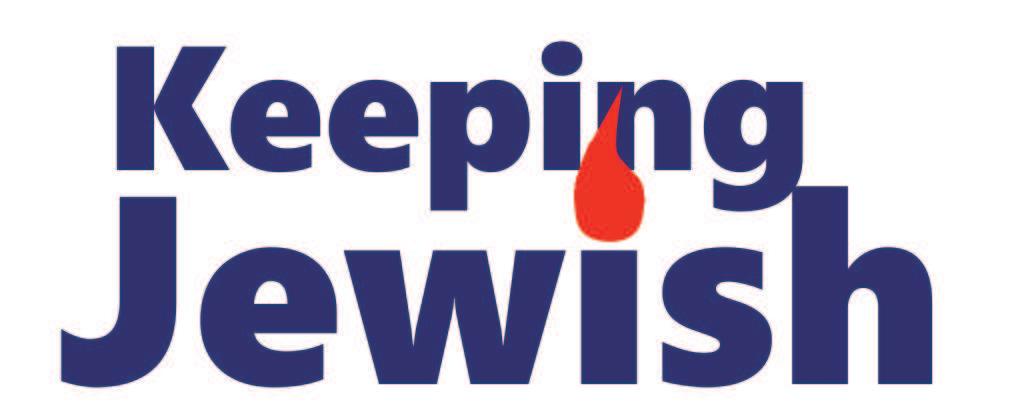

Tradition, Inspiration and Celebration · February 2023 - Shevat 5783 · Published by Chabad Tucson BS”D JEWISH EDUCATION grows in Tucson Lamplighter Day School & Preschool moves into modern new building Precious lessons What you can learn from can learn from Tucson Gem Show sellers The Bolivian ‘Schindler’ Tin baron Moritz Hochschild is now being called a hero Welcome to town Dr. Ben Lombardo believes in the power of healing Hail to the Chief Quiz yourself on the Jews on the Jews and the U.S. presidents Happy Tu Bishvat: Observing the New Year of Trees, 10 historic trees and a fun craft
The Jewish outreach and education network of Southern Arizona
2443 E 4th Street, Tucson, AZ 85719
EXECUTIVE DIRECTOR
Rabbi Yossie Shemtov
REBBETZIN
Chanie Shemtov
OUTREACH DIRECTOR
Rabbi Yehuda Ceitlin
PROGRAM DIRECTOR
Feigie Ceitlin
Affiliates:
Congregation Young Israel, Chabad at the University of Arizona, Chabad on River, Chabad of Oro Valley, Chabad of Sierra Vista, Chabad of Vail and Lamplighter Chabad Day School of Tucson

EDITOR
Rabbi Yehuda Ceitlin
COPY EDITOR
Suzanne Cummins
CONTRIBUTING WRITERS
Feigie Ceitlin, Roberto Loiederman, Menachem Posner, Melinda Mindy Ribner, Mordechai Schmutter, Chana Scop, Lilian Wasserman, Benjamin Weiss
PHOTOS
Jacqueline Soffer Studio
SPECIAL THANKS
Chabad.org, Jewish Journal
EDITORIAL INQUIRIES OR ADVERTISING
Phone: 520-881-7956 ext. 12
Email: info@ChabadTucson.com
Keeping Jewish is published in print periodically by Chabad Tucson and is distributed free in Tucson and around Southern Arizona
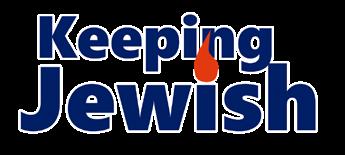
Chabad Tucson does not endorse the people, establishments, products or services reported about or advertised in Keeping Jewish unless specifically noted. The acceptance of advertising in Keeping Jewish does not constitute a recommendation, approval, or other representation of the quality of products or services, or the credibility of any claims made by advertisers, including, but not limited to, the kashrus of advertised food products. The use of any products or services advertised in Keeping Jewish is solely at the user’s risk and Chabad Tucson accepts no responsibility or liability in connection therewith.
Note: “G-d” and “L-rd” are written with a hyphen instead of an “o .”This is one way we accord reverence to the sacred divine name. This also reminds us that, even as we seek G-d, He transcends any human effort to describe His reality.
Seven lessons learned from gemstone dealers
By Rabbi Yehuda Ceitlin
Every February, a red carpet is rolled out at the Tucson Convention Center, signaling the opening of the AGTA GemFair as part of the annual Tucson Gem, Mineral & Fossil Show. Some 65,000 guests from around the world descend upon southern Arizona to buy, sell and trade colored gemstones, cultured pearls, and exquisite jewelry at the various expos.
Observing sellers last year provided me with some valuable life lessons.
1. Begin the day with agility. As the sun rises each morning of the expo, sellers arrive early and swiftly prepare for the day ahead. They build beautiful booths and get ready to welcome the crowds, making do with what they have.
“Whatever one is happy doing, he does it with agility,” the Baghdadi scholar known as the Ben Ish Chai taught, encouraging us to begin the mornings with joy and enthusiasm.
2. Welcome everyone with a smile. Buyers come to the expo looking for a good deal, but many of the sales happen thanks
to the sellers’ upbeat attitude and interpersonal skills.
The Ethics of Our Fathers tells us to “receive all people with a pleasant countenance” (Avot 1:15). The commentator HaMeiri adds that even if one isn’t actually thrilled to meet a fellow, fake it: “put on a happy face.”
3. Don’t forget the VIBs (very important buyers).
While it’s nice to be welcoming to everyone, a group of people at the expo called the VIBs — very important buyers – gets all the attention they need and then some. After all, closing a deal with a VIB may be worth hours or days of smaller purchases.
A principal in Jewish law called “Ikar v’tafel” distinguishes between “primary and secondary” for reciting blessings on foods. The VIBs in our life - the people we love, the commitments we make, and the causes we care about - should be treated with top priority.
4. Don’t be deterred by a slow start. The first day or two of the expo tends to be
slow, but the sellers aren’t concerned. “It takes time to warm up,” one of them told me. “They came here to make a purchase, but they need time to get familiar and feel at ease.”
“Warming up” is essential. When it comes time for us to pray, we don’t just jump in from a cold start. Instead, we begin with a series of introductory “Verses of Praise,” acknowledging G-d and awakening our attachment to Him before moving on to the core prayers.
5. Don’t be flustered by glitz. When my young children toured the expo, they were enthralled by the large shiny stones and the unique ones shaped like animals. But both sellers and experienced buyers know that glitz doesn’t equal quality.

We are well advised when we are told to “Look not at the vessel, but at what it contains” (Avot 4:20). It’s worth taking the time to inspect quality.
6. See opportunity everywhere. To the sellers, there’s no such thing as a chance encounter at the expo. Everything from a chat in the parking lot to an encounter over lunch is seen as a potential business opportunity.
The Ba’al Shem Tov, founder of Chassidism, taught that every encounter we have takes place because of Divine personal providence. Every encounter is an opportunity to learn a lesson or make a difference.
7. Place your treasures in trusted hands.
When it comes to closing time, the sellers carefully place the gemstones into velvetlined cases. A team of security guards then takes the merchandise to be stored for the night under heavy (and well-insured) protection.
We have a similar routine at the conclusion of our day. “Into Your hand, I entrust my spirit,” King David said (Psalms 31:6). As we go to sleep, we entrust our souls to the care of our keeper, and we are confident that He will return them to us in the morning - for another bright new, happy and successful day.
- Rabbi Yehuda Ceitlin is the Outreach Director of Chabad Tucson.
| February 2023 | Keeping Jewish
2
Mendel Ceitlin inspects a stone at the AGTA GemFair Tucson, February 2022
OPINION
Lecture to discuss Israel’s new government
By Benjamin Weiss
The profound challenges and opportunities that the Holy Land of Israel is currently facing will be discussed at an upcoming guest lecture titled “Where is Israel heading to? An Insider’s View on Peace and Politics.”
Presenting will be Gil Hoffman, who served as chief political correspondent and analyst for The Jerusalem Post for 24 years. He is now the executive director of HonestReporting, which monitors international and social media. He is also a lecturer on political strategy at Israel’s College of Management.
Hoffman is visiting Arizona to talk for the Jewish National Fund’s Annual Arizona Breakfast for Israel in Phoenix, and for Chabad Tucson, the Jewish outreach and education network of Southern Arizona. His talk in Tucson will be on Thursday, February 23, at 7:00 PM, at The Shul -


2443 E 4th Street. Following the lecture, Hoffman will be taking questions from the crowd.
Hoffman was raised in Chicago, graduated Magna Cum Laude from Northwestern University’s School of Journalism, and wrote for the Miami Herald and the Arizona Republic before moving to Jerusalem, where he lives with his family.
A reserve soldier in the IDF Spokesperson’s Unit, he has lectured in every major English-speaking country in the world and more than half the Canadian provinces. He recently made history in Hawaii by becoming the first speaker to have lectured about Israel in all 50 U.S. states.
Well-connected to Israeli and Palestinian leaders, he has interviewed every major figure across the Israeli political spectrum
and is a regular analyst on CNN, Al-Jazeera and other news outlets. Called “The most optimistic man in Israel” by Israel Television, Hoffman provides a behind-thescenes look at the intrigue and humor in the Israeli political arena.
Hoffman says he has noticed a negative tone in how the international media covers the recently formed government of Benjamin Netanyahu, the country’s longest-serving prime minister. Within Israel, there have been mass protests against the planned legal and constitutional reforms the Netanyahu administration is proposing.
“There are strong points of view on both sides,” Hoffman recently told ILTV news. “Both sides believe that if their view does not win, it will cause tremendous damage to the future of the state of Israel. The fact that they’re using such strong language
from the get-go just shows how intense this is going to get over time.”
Putting the division into context, Hoffman says that “Israelis are not hyper-polarized over diplomatic, security and economic issues. That’s why the legal reforms that highlight the differences really stand out.”

In an optimistic tone, Hoffman says: “In the end, we are one people. There is a pendulum in Israeli politics and things will swing across ideologies. I think people understand that you have to have healthy discourse in a democracy even when you have strong opinions.”
The lecture in Tucson is open to the wider public. Tickets are $18 per person and will be sold at the door or online at ChabadTucson.com/IsraelLecture
Keeping Jewish | February 2023 | NEWS
David Grossman (center), Director of the Institute of Jewish Chaplaincy who was named the Civil Air Patrol Chaplain of the Year, speaks at Chabad of Oro Valley about the life of Jews in the military.
Rebbetzin Sara Shanowitz (right) and students present the chocolate babkas they baked during a program of the Chabad at the University of Arizona.
3
Gil Hoffman (right) interviewed on the Detroit Today radio show * Photo: Jake Neher/WDET
JEWISH EDUCATION grows in Tucson
Lamplighter Chabad Day School
Preschool moves into a modern new building
By Lilian Wasserman · Photos by Jacqueline Soffer Studio
Over this past year, a 10,815-square-foot building in the Palo Verde neighborhood in Tucson, Arizona, has undergone extensive renovation. The entire interior has been gutted and replaced by expansive color schemes, bright lighting, designer flooring, and top-of-the-line furnishings. The exterior was also overhauled, with the parking lot covered in brick pavers and LED lights.
Everything has been reimagined and redesigned - except for one specific feature.
The untouched element is four distinctively tall palm trees rising over the entrance of 3830 E Bellevue Street. Having grown to a remarkable height over time, those trees possibly predate the building that is tucked between the Varsity Clubs hotel, the Casa Blanca event venue, and the midtown branch of the Tucson Federal Credit Union.
The one-story building is the new home of the Lamplighter Chabad Day School and Preschool of Tucson. For Rabbi Yossie Shemtov, Executive Director of Chabad Tucson, keeping those trees growing was an educational opportunity that also exemplified the school’s mission.
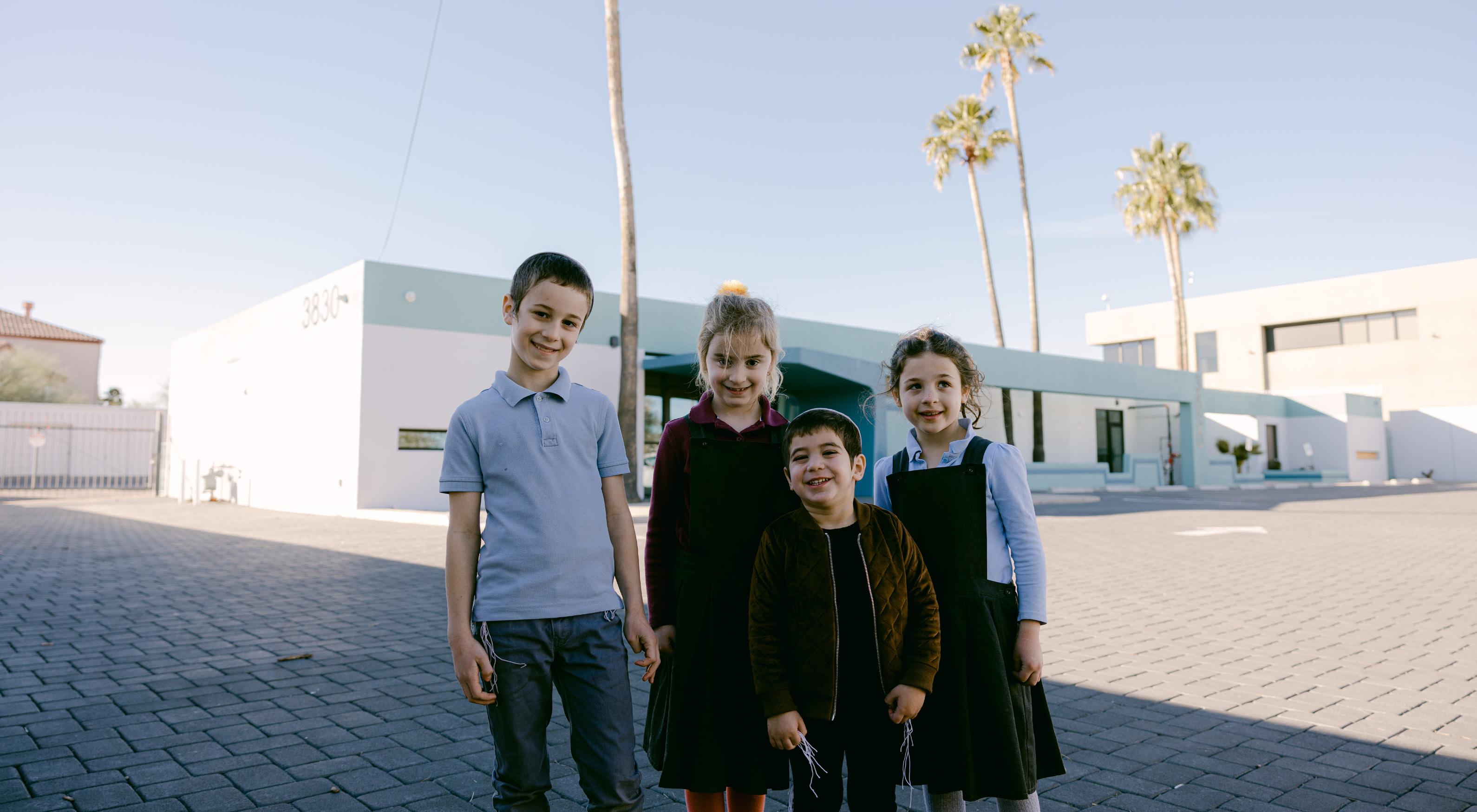
“The Midrash tells of a 100-year-old man who was planting a tree,” Rabbi Shemtov shared. “When the man was asked if he expected to live long enough to enjoy the fruits of his labor, he replied: “My ancestors planted for me, and now I plant for my children...”
“Our palm trees are symbolic of our school’s commitment to its students to help them grow in their Jewish values, education, and continuity,” Rabbi Shemtov said. “It also conveys our education
approach, to provide strong roots and constant nurturing, allowing each child to blossom in his or her way.”
Unsurprisingly, students at Lamplighter are learning about the Torah’s view of the botanical world ahead of Tu Bishvat, the 15th of Shevat, which marks the beginning of a “new year” for trees. The young boys and girls of preschool will also plant tree seedlings in school and grow their garden.
Humble beginnings
The roots of the Lamplighter school date back to October 1983, when Rabbi Shemtov and his wife, Rebbetzin Chanie Shemtov, established Chabad Tucson with the blessing of the Rebbe, Rabbi Menachem M. Schneerson, of blessed memory, spiritual leader of the Chabad-Lubavitch movement.
The Rebbe strongly advocated for better Chinuch (Jewish education) and argued that education was “the cornerstone not only of Jewish life but of humanity at large.” The U.S. President annually proclaims Education and Sharing Day on the Rebbe’s birthday in recognition of his lifelong efforts for education.
“Proper education means giving our children a delicate balance,” the Rebbe said in a talk given just a month before the Shemtovs embarked to Arizona.
“They must know Torah’s unwavering fundamentals – principles which cannot change, regardless of the circumstances. At the same time, however, the child is told to continually grow and be innovative in his or her life’s mission. Just as the child’s body constantly grows, so must the child’s soul grow every single day.”
| February 2023 | Keeping Jewish PROFILE
4
Students stand in front of the new building of Lamplighter at 3830 E Bellevue Street
&
The Shemtovs took this instruction to heart and dedicated countless hours to teaching children in one-on-one sessions alongside their responsibilities and programs for the wider community. They later prompted the Orthodox Jewish education track at the Tucson Hebrew Academy (which has since been discontinued). They also operated classes out of Congregation Bet Shalom, Congregation Young Israel and Castlehill Country Day School.
When demand grew, Rabbi Shemtov set out to purchase the building on E Bellevue Street, which belonged to Our Family Services. A crowdfunding campaign that attracted 388 individual donors, with additional funding by philanthropist Mario de la Fuente Manriquez, provided for the downpayment in June 2020.
“It was heartwarming to see how current and past members of the Jewish community in Tucson acknowledged the importance of authentic Jewish education, and kindly contributed to the initial campaign just as the Covid-19 pandemic had begun,” Rabbi Shemtov commented.
A construction crew led by Sally Bach of G2 Contracting got to work. The architect was Rhonda Rawson of American Design Consultants and the interior designer was Rikvah Baitelman of Los Angeles, California.
The result is a beautiful and modern school building equipped with state-of-the-art features. “It’s absolutely gorgeous,” Clay Abernathy, Vice President and Founder
of the IDEA’L construction trade school in Tucson, commented about the result. In fact, Abernathy filmed two episodes about Lamplighter for his online video series about local developments.
Steller staff
While it is impossible to look at the physical building and be impassive, what goes on inside the school is the most important. Lamplighter has a clear vision as a provider of both a Torah-true Jewish education and a General Studies Academic program in a caring, loving, and wellrounded environment.

“I like to say that our Judaic teachers are overly qualified,” says Rebbetzin Feigie Ceitlin, the head of school. “Our staff is comprised of local Chabad Rabbis and Rebbetzins who bring their extensive knowledge, vigorous faith, and exceptional care to the classroom. We’re blessed to have such a high caliber of teachers willing to work with each child on their level.”

With regard to secular studies, “All primary levels learn reading, math, and science led by experienced teachers,” Ceitlin says. Recent projects include an “I Have a Dream” art composition in honor of Martin Luther King Jr. Day, a lemon batteries experiment, and writing ad copy for a fictional marketing campaign.
And there is lots of activity with the younger students at the preschool. Jackie Soffer says she was surprised and delighted when her three-year-old son
Ruben set up a Shabbat party at home and was reciting blessings on food by himself.
“We were looking for a Jewish school in Tucson, and Lamplighter seemed like a great choice,” says Soffer, a wedding and destination photographer. “They teach through action and with love, and Ruben loves his classmates and his teachers. He asks why he cannot go on the weekends to play and be with his friends.”
Ceitlin says that one of the first questions young families ask when considering moving to a Jewish community is the quality of the education. “With Lamplighter, we can now confidently answer that authentic, wholesome, and individualized Jewish education is available in Tucson,” she states.
Next year, students at Lamplighter will range from 1-year-olds to 7th graders. Ceitlin finds that the most rewarding part of her day is hearing the children learning. “It is heartening to hear each child’s voice learning something new every minute of the day,” she says. “We are very proud of them.”
The beautiful palm trees that grow in front of the Lamplighter school can be seen as part of the Jewish belief that what is “planted” during childhood will continue to nurture them as they grow. Like the trees, their school experience should leave them sturdy in faith and culture, sharing their stature with all who are around them.
Getting involved
Enroll: Enrollment is now open for the 2023-2024 school year for toddlers through 7th grade. Schedule a personal tour by contacting 520-881-7956 ext. 2 or office@lamplightertucson.com.
Donate: Various dedication opportunities are available in the new building, and in the second phase of the construction that will soon expand the school. Contact Rabbi Yossie Shemtov at 520-8817856 ext. 11.
Tuition tax credit: By donating to a school tuition organization for Lamplighter Chabad Day School, you receive a full tax credit back when you file your Arizona state taxes. For more, visit ChabadTucson.com/tuitiontax.
* Leave a legacy: Make a charitable bequest in your will to Chabad Tucson / Lamplighter Chabad Day School. For more, visit ChabadTucson.com/legacy or call Rabbi Yehuda Ceitlin at 520881-7956 ext. 12.
Keeping Jewish | February 2023 | 5
Rabbi Yossie Shemtov leads small davening (prayer) groups at LamplighterEliya and Sholom play outside during break at Lamplighter
HISTORIC TREES IN THE TORAH
The 15th of Shevat on the Jewish calendar—celebrated this year on Monday, February 6, 2023—is the day that marks the beginning of a “new year” for trees. Commonly known as Tu Bishvat, this day marks the season in which the earliestblooming trees in the Land of Israel emerge from their winter sleep and begin a new fruit-bearing cycle.
Let’s take a moment to explore 10 wonderful trees (or groves) whose stories are woven into the familiar (and not so familiar) narratives of the Torah.
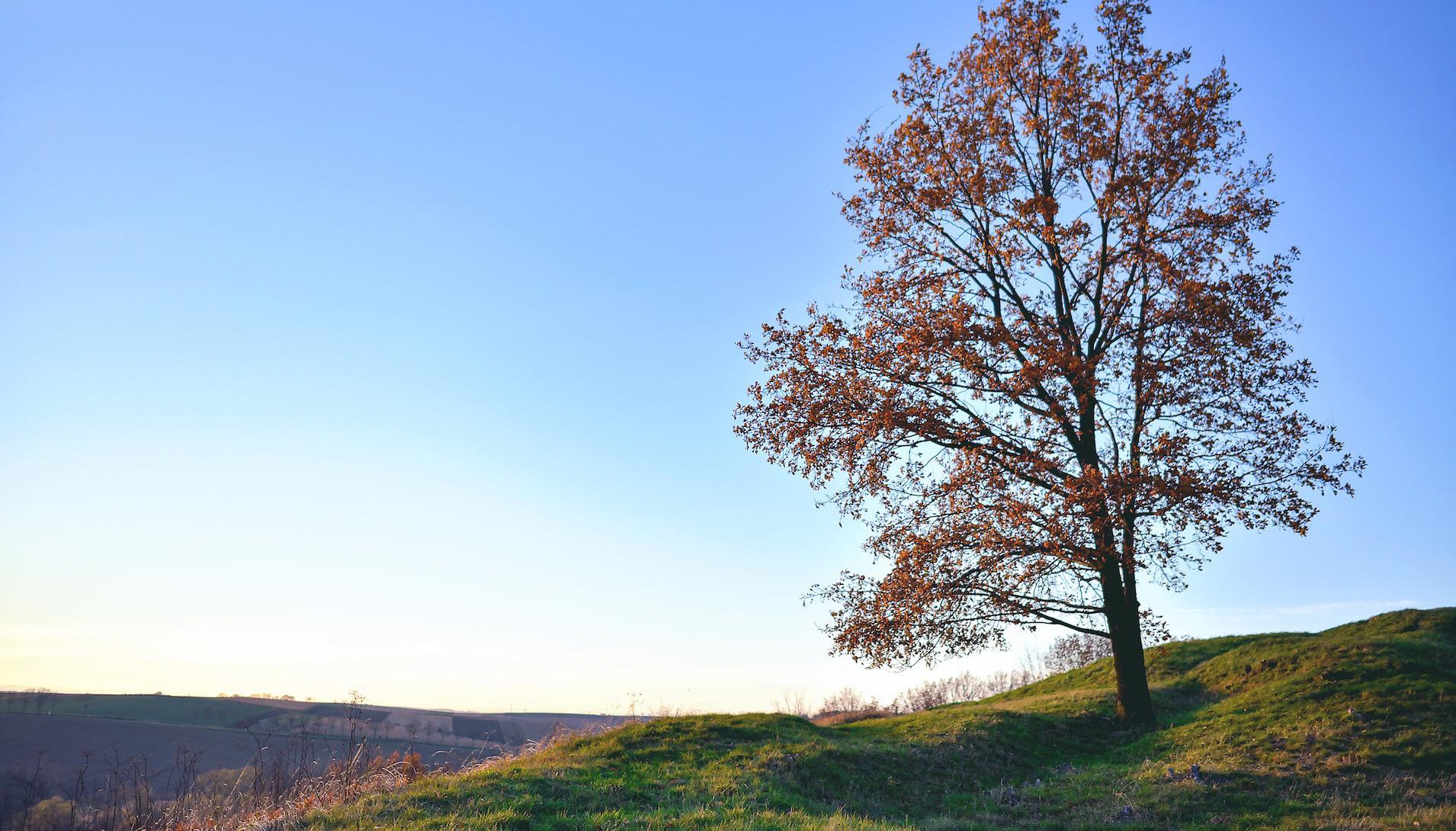
1. The Tree of Knowledge
G-d created Adam and Eve and placed them in the Garden of Eden, where they were free to enjoy all the produce except for that of the Tree of Knowledge, which they were forbidden to eat lest they “become like G-d” and learn about evil. But the serpent convinced Eve to have some of the fruit and share it with Adam. Innocence lost, their
By Menachem Posner
eyes were opened to the possibility of sin, and they recognized that they were naked.
2. The Tree of Life
After Adam and Eve gained knowledge of sin, G-d said: “Behold, man has become like one of us, having the ability to know good and evil. And now, lest he stretch forth his hand and take also from the Tree of Life and eat and live forever.” G-d expelled Adam and Eve from the garden and stationed the cherubim and the blade of the revolving sword at its entrance to guard the way to the tree which would have apparently provided Adam and Eve with the everlasting life they had lost by eating from the Tree of Knowledge.
3. The post-flood olive tree
Ten generations later, the descendants of Adam and Eve had become so sinful that G‑d flooded the world, saving only Noah and his immediate family. Eager to see if the water had receded, Noah sent out
a raven, but the bird did not fly far and merely circled the ark. Next, Noah sent out a dove for a total of three missions. The first time the dove left the ark, it returned without any results. The second time it returned with an olive leaf in its beak, indicating that new growth (namely, an olive tree) had begun to sprout. (The third and final time, it did not return, having found rest outside the confines of the ark, indicating that the water had receded enough for Noah and his family to leave as well.)
4.Abraham and Sarah’s tree
Another 10 generations pass, and we are introduced to Abraham and Sarah, whom G-d selected as the progenitors of His chosen people. When Abraham and Sarah were 99 and 89, respectively, G-d dispatched three angels (disguised as humans) to visit them and inform them that they would be blessed with a son, Isaac. This happened just three days after
Abraham had circumcised himself, yet as soon as he saw the men approaching, he ran toward them and offered them hospitality. He gave them water to wash their feet and then seated them under a tree. For many generations, the residents of Hebron kept a tradition regarding the identity of this tree.
5. Shechem’s treasure tree
Isaac’s son, Jacob, was the father of 12 sons and one daughter, Dinah. After Dinah was raped by the prince of Shechem, her brothers, Simeon and Levi, exacted revenge against the denizens of the city, who were complicit in her violation. They also helped themselves to the treasures of the city. Jacob commanded his family to remove all idols and accessories, which he buried under a tree (of a species that bears no fruit) near Shechem. They were then ready to travel to Beth E‑l and sacrifice to G‑d there.
| February 2023 | Keeping Jewish
101 6
JUDAISM
10
Photo by Boguslaw Nowak / Pexels
residents Dinah revenge were helped buried ready G‑d
6.
The nurse’s tree
Just a few verses later, “Deborah, Rebecca’s nurse, died, and she was buried below Beth E‑l, beneath the allon; so he named it ‘Allon Bachuth.’” Now, what is an allon? The commentator Rashi says it is a plain. Others, however, identify it as a tree.
7.
The burning bush
Jacob and his family eventually migrated to Egypt, where Pharaoh enslaved them until G‑d dispatched Moses to redeem them from their suffering and lead them toward the Holy Land. G‑d first appeared to Moses in the form of a bush that was miraculously burning without becoming consumed by the fire. (Though technically not a tree, it seems close enough to be worthy of mention as, like a tree, it was resilient and impressive).
8.
The sweet tree
Ten days after Moses led the People of Israel out of Egypt, they ran out of water and had only the bitter waters of Marah (which means “bitter”) to drink. The people complained to Moses, saying, “What shall we drink?” So he cried out to G‑d, and G‑d instructed him to cast a piece of wood (the branch of an olive tree) into the water, and the water became sweet.
9. The 70 palm trees
From Marah, they came to an oasis named Elim, where there were 12 springs of water, one for each tribe, and 70 date palms, corresponding to the 70 elders, each of whom sat under another tree to praise G‑d. The commentator Ibn Ezra says they were actually 70 types of trees.

10. Jacob’s cedars
Although not mentioned directly in Scripture, the story of Jacob’s cedars is fascinating. Months after they had left Egypt and were deep into their desert wanderings, the Israelites constructed a magnificent traveling temple (the Tabernacle, or Mishkan) of heavy beams, held together with gold and silver fittings, and covered with tapestries and skins. Where did they get the wood? The sages say that on his way down to Egypt, Jacob had his sons plant cedar trees, which grew and flourished until they were needed.
Observing Tu Bishvat
We mark the day by eating fruit, particularly from the types of fruit for which the Holy Land is praised (Deuteronomy 8:8): olives, dates, grapes, figs and pomegranates.
In Jewish law, a fruit is defined as something growing from a perennial tree that does not renew its stem and does not grow too close to the ground. Thus, apples, grapes, nuts (except peanuts) and figs are fruit, but strawberries, watermelon and bananas are not.
Before eating, recite the blessing on fruits ‑ Borei Pri Ha’etz:
Baruch atah A‑donay, Elo‑heinu Melech Ha’Olam borei pri ha‑aitz.
Translation: Blessed are You, L‑rd our G‑d, King of the universe, who creates the fruit of the tree.
If tasting any of these fruit for the first time this season, recite the Shehecheyanu blessing first and then the standard “Ha’etz” blessing:
Ba‑ruch A‑tah A‑do‑noi E‑loi‑hei‑nu Me‑ lech ha‑o‑lam she‑he‑chee‑ya‑nu v’ki‑yi‑ ma‑nu vi‑hi‑gi‑ya‑nu liz‑man ha‑zeh.
Translation: Blessed are You, L‑rd our G‑d, King of the Universe, who has granted us life, sustained us and enabled us to reach this occasion.
For more about the holiday, visit Chabad. org/15shevat

Keeping Jewish | February 2023 |
7
Dr. Benjamin Lombardo grew up in Westchester County, NY, the son of two psychiatrists. After Columbia University in Manhattan, Ben grew passionate about yoga and meditation and continued to study and teach these arts for most of his twenties. Then, after traveling in Asia, he decided to pursue a medical degree and graduated from SUNY Downstate College of Medicine in Brooklyn in 2021.
Moving to Tucson: I moved to Tucson in June of 2022 to start residency in Family Medicine with Banner - University Medical Center. Tucson has been an incredibly inviting and magical place to live. I had spent too much time in the big city and am now very glad to be here!
Currently reading/learning: The Artist’s Way by Julia Cameron.
Welcome to town: Dr. Benjamin Lombardo
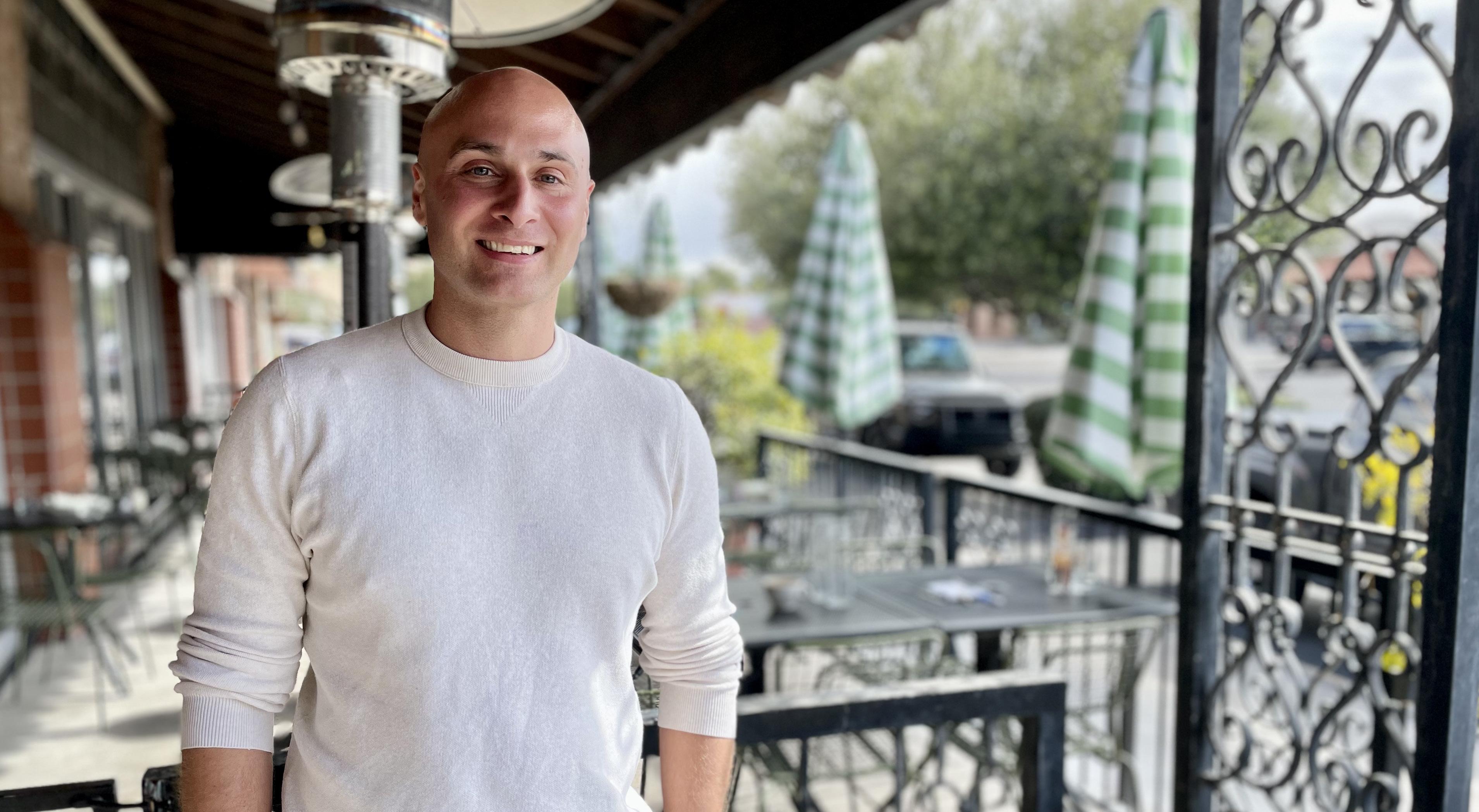 By Benjamin Weiss
By Benjamin Weiss
Favorite Mitzvah/holiday: Cooking for others.
Cherished Jewish memory: Listening to my temple choir sing as a young boy. It was the first time I could remember feeling the presence of G-d.
Jewish app on phone: Chess.com (we have always had a strong presence in the chess world).
Go-to Yiddish or Hebrew word: Mishegoss (Yiddish for craziness, lunacy, foolish behavior or situation).
Historical Jewish figure: Albert Einstein.
Afamily story: My surname is Italian, and because I’m of Jewish-German origin, friends at school
would call me Lombardo-shtein. We got the name because my father was given up for adoption at birth and was taken in by an Italian family in the Bronx. He only learned about his Jewish lineage in his 30s. When I was born, it was important to him to raise me Jewish and give me what he didn’t get.
Chabad: Chabad were my neighbors all throughout medical school in East Flatbush, Brooklyn. A pleasant surprise to find you here in Arizona too!
Chesed (kindness):
When I see patients, I strive to give my utmost presence and heartfelt attention to everyone. I feel that regardless of whether I am able to treat what ails them, to be seen and heard is medicine in itself.
Happiness: Beautiful surroundings and good company.
Hobbies: Dancing, Tai Chi, meditation and hiking. Comfort food: Potatoes of any kind.
Kvetch: My residency schedule!
Kvell / nachas: Synchronistic meetings.
Your claim to fame: Was highly ranked in the U.S. as a foil fencer during my teens.
Something you’re looking forward to… Spring in Tucson!
| February 2023 | Keeping Jewish 8
Martha’s chocolate chip mandelbrot
By Feigie Ceitlin
During my visits to Brooklyn, I would love to visit the home of aunt Martha Stock with my cousins. Technically, she was our great-aunt, but we felt extremely close to her. Her home was warm and welcoming. The highlight was when she served us her chocolate chip mandelbrot, a humble pastry that is described as a Jewish cookie. Today, my cousins and I swear by this recipe, and so do the guests we serve them to.
INGREDIENTS:

3 eggs
1 cup oil
1 teaspoon vanilla
1 cup sugar
3.5 cup flour
2 teaspoon baking powder

1 bag of chocolate chips
DIRECTIONS:
Preheat the oven to 350°F.
In a bowl, combine all the ingredients and
stir by hand until everything is mixed together.
Form the dough into two oval mounds on a baking sheet lined with parchment paper.
Bake for 20-30 minutes or until the sticks are golden brown.
Allow them to cool slightly and slice into sticks while still warm.

The blessing: Mezonot

Baruch atah A-donay, Elo-heinu Melech Ha’Olam borei minei mezonot. Blessed are you L-rd our G-d, King of the Universe, Who creates various kinds of sustenance.
Enjoy!
Keeping Jewish | February 2023 | KOSHER
*
- Rebbetzin Feigie Ceitlin is the program director of Chabad Tucson and head of school of Lamplighter Chabad Day School
9
Photo by Jacqueline Soffer Studio
Genia Farkas is 102 years old and lives in a retirement home in Israel. Recalling how she survived the Nazi era, she said that in 1938, when she was 18, she left her hometown of Ulanów, Poland and joined her sister and her sister’s husband in Brussels, Belgium. Her brother-in-law had spent time in Germany and had seen evidence that alerted him to the coming tragedy.
By 1939, World War II was already raging, and Genia’s brother-in-law pushed for the three to leave Europe. When they learned that Bolivia was virtually the only country open to Jewish immigration, they requested and received their life-saving visas to that landlocked, poor, politicallyunstable country in the middle of South America.
The three of them boarded a ship, and the first few days at sea were terrifying. While still near Europe, the vessel, carrying many Jewish passengers, did not travel at night for fear of mines. Lights were turned off and everyone wore life jackets at all
By Roberto Loiederman
times, even in bed. Once the ship was well into the Atlantic, they could breathe more easily. Weeks after leaving Europe, the three disembarked in Arica, Chile, then boarded a train that became known as the Jewish Express.
Visas in hand, they entered Bolivia, which was as alien to Genia as if she had landed on the moon. But at least they’d survived, and they were far away from the SS and concentration camps. After a year in Bolivia, Genia managed to cross the border into Argentina, where she lived for the next 35 years, raising a son and a daughter. (Full disclosure: Genia is this reporter’s mother-in-law, and the story of how she survived is an amalgam of many conversations.)
Genia was one of at least 9,000 and perhaps as many as 22,000 Jews who found refuge in Bolivia. The man behind this effort was Moritz (Mauricio) Hochschild (1881-1965), a mining magnate whose mines accounted for a sizable percentage of Bolivia’s exports.
In the 1930s and early 1940s, Hochschild, a non-observant German Jew, hobnobbed with Bolivia’s elite, including presidents, generals and business leaders. Because of his huge economic influence, Hochschild was able to convince Bolivian government officials that it was in their economic interest to offer visas to imperiled European Jews. As a result of Hochschild’s cajoling, the Bolivian government decreed, in June 1938, that its “doors are open to anyone … who is healthy in body and spirit, anyone who wants to come and work.”

Hochschild’s efforts have come to light relatively recently. After Bolivia nationalized the mining industry in 1952, Hochschild’s business in Bolivia was shut down. The company’s offices, in a suburb of La Paz, were left alone for many years and fell into ruin. In 1999, decades after Hochschild’s 1965 death, a search in the mining operation’s offices turned up a trove of important papers from the 1930s and 1940s. A team of masked and gloved investigators moved in and began to study
and catalog thousands of letters, receipts and other documents. In 2004 those investigators began releasing some of what they’d found, and they have continued to do so, posting the results in public archives.
What they discovered was that besides saving thousands of Jewish lives during the war, Hochschild also shipped tin and other raw minerals to smelters in the U.S. at a below-market price, providing the U.S. with materials for making ammo boxes, weapons, medical equipment, airplane parts and tin cans that preserved food. In his lifetime Hochschild did not publicize his heroic role. In fact, he was called a “ruthless tin baron” who paid low wages to his employees. He was subjected to antisemitic slurs by Bolivian politicians and journalists who garnered support when they called him a “foreign exploiter” and “the worst kind of businessman.”
The letters and documents that have been made public decades after his death have led to a reassessment of Hochschild. Rather than labeling him a “ruthless exploiter,” he’s now called “the Bolivian Schindler.”
Kidnapped and jailed mogul
Moritz (Mauricio) Hochschild was born in 1881 into a middle-class Jewish family in Biblis, Germany, a suburb of Frankfurt. He studied mining engineering in nearby Freiberg, then worked as a mining engineer in Spain. After that, he spent five years in Australia’s mining areas. He then went to Chile, where he continued to work in different aspects of the mining industry: buying ore and selling it to smelters abroad. In 1919, one year after World War I ended, he returned to South America, this time to Bolivia, where he lived and worked for the next 25 years.
In 1947, long before his heroic actions became known, the financial magazine Fortune described Hochschild this way: He is “a slightly mysterious South American mining overlord … [with] a great, bald boulder of a head, burning eyes under bushy brows, and a heroic nose leading down to a bristling mustache.”
The article points out that “the most remarkable thing about the remarkable
| February 2023 | Keeping Jewish
HISTORY
Was Moritz Hochschild a ruthless capitalist or a heroic rescuer?
10
“The Bolivian Schindler” “The Bolivian Schindler”
Moritz Hochschild in Lima, Peru
c.1962 * Photo: Irene Brann
Hochschild head is that it has remained comfortably affixed to his shoulders … though so often in danger.” Hochschild was a mining mogul in a country where wealthy entrepreneurs were sometimes jailed or kidnapped and he was subjected to both of those indignities: jailed twice, and kidnapped once. When he refused to go along with what he considered an unfair government demand, one Bolivian president even threatened the Jewish mining titan with execution, a threat that was not carried out, his advisers having talked the president out of having Hochschild killed.
His having been jailed, kidnapped and threatened may explain why Hochschild remained secretive about his role in bringing refugees to Bolivia. When writing to American Jews involved in bringing European Jews to Bolivia, however, Hochschild was open about his involvement.

In the trove of documents that have been made public, there’s an April 1940 letter from Hochschild to James N. Rosenberg,

Chairman of the Agro-Joint project—an agency that placed Jewish refugees in farms located in various countries. When writing to Rosenberg, Hochschild was clear about his role in how the visas came about: “I arranged with the [Bolivian] government that we could bring in a total of 30,000 Jews for colonization.”


Though this letter was a plea for more money to help settle Jewish refugees, it’s also clear from other documents that Hochschild used vast amounts of his own money in his efforts to save Jews and help the Allies win the war.
There’s no doubt that Hochschild exploited workers who made him wealthy. On the other hand, he saved tens of thousands of Jews and helped the Allies win the war. Saint or devil? This complex man was probably a bit of both, like most of us.
- Roberto Loiederman is a writer for The Jewish Journal of Los Angeles and co-author of “The Eagle Mutiny,” a nonfiction account of the only mutiny on an American ship in modern times. This article was first published in the Journal.
Keeping Jewish | February 2023 |
11
Moritz Hochschild’s mining facility in Potosi, Bolivia, December 1932 * Photo: Leo Baeck Institute
Jewish children at a kindergarten in Bolivia funded by Moritz Hochschild, c.1944
Identifying as a Jew on campus
By Melinda Mindy Ribner
It may have been in my second or third year of undergraduate school when I began wearing a Jewish Star of David and identifying myself publicly as a Jew. At the time, I was not affiliated with any synagogue and was not learning Torah. I knew lots of Jews, but I didn’t know anyone who identified in public as a Jew or wore a Jewish star (“Magen David”). Choosing to wear one visibly at that time was actually a demonstration of considerable courage and faith on my part. Yet I also felt that I had no choice so the world could see me as a Jew.

It was the late 1960s and ‘70s, and on the very day that my parents dropped me off for my freshman year, we were greeted with a nude protest on the front lawn of the main campus building. We walked through the group with our heads down. My parents were speechless; I don’t recall ever talking to them about what we witnessed. I was confused but also inwardly excited by how outrageous, and unconventional college life would be.
I remember feeling like a farm girl from Idaho next to the sophisticated students from New York City. I grew up very
sheltered, attended a high school with only 60 people in my grade, and was involved in Jewish extracurricular activities. I didn’t have many dates, as my father would not allow me to stay out past 10 PM. Now here I was in college, living on my own.
My roommate that year was a beautiful Jewish woman from Long Island, N.Y., with long, bleached-blond Cleopatra-style hair, who sported mini-skirts and pearls. She looked more like a model or movie star than a college student. In our few limited conversations, she distinguished herself as a worldly sage who clearly knew more about life than I did. Much to my chagrin, she spent only the first two or three nights in the room with me. I had no idea where she was or what she was doing. Occasionally, she stopped by briefly for a change of clothing. By January, however, she dropped out of college completely to travel with a graduate student she had been living with. So I basically had a private room.
In those early months of college, I was confronted for the first time with promiscuity, drugs, tear gas, and a variety of alternative lifestyles and ideologies. I
| February 2023 | Keeping Jewish
12
LIFE
The Jewish star was my signal to G‑d, to myself, and to others
Photo: CottonBro Studio/Pexels
so much wanted to belong and participate in the visionary awakening taking place on the college campus. I was attracted to the universality, expansiveness and spirit of egalitarianism of the ideology being promulgated in and out of classes.
I was excited, even thrilled, to meet and dialogue with the kinds of people I would never have met in my small private high school. I was amazed that I even had conversations with charismatic leaders of Communist/Socialist anti-American revolutionary movements right in the college meeting center. But when these radical socialists began to denounce Israel, I knew I could no longer associate myself with them; bashing Israel was a red line— then and now—that I would never cross.
I became confused about who I really was. My values were challenged. Was I simply a product of my parental, societal, or peer values, or did I have a more transcendental, more essential inner self? Why was I born? What was my purpose? What is life? I was haunted by deep existential questions. Life itself felt like an existential question. Even though I was popular in college and had dates most nights, I was lonely and troubled. Taking courses in sociology and philosophy only added to my anxiety and discomfort. Therapy offered me no relief. In my despair and loneliness, I called out to G-d and began to meditate on my own.
My inner life was rich, deep, and intense. I talked to G-d, and then I listened deep inside. In an effort to diminish my personal anguish, I sought to attach myself to G-d. G-d became the only source of inner strength for me in a world that I felt was going mad.
In the midst of my loneliness and despair, I sought out a campus rabbi. He advised me not to think so much and to take up a physical activity, like swimming. He also recommended some Jewish books that addressed the existential questions that so deeply troubled my soul. I became ecstatic meditating on these teachings, and no


longer felt so alone; still, I had no one to talk to about what was taking place within me.
One day, I happened to listen to a folk song that implied that it was cowardice not to tell the world that G-d is your healer, G-d is your strength. The words were something like: “You come to G-d in secret, G-d heals you, gives you strength, and yet you hide that experience and are afraid to tell the world Who healed you.” It was at that moment that I decided to wear my Jewish star; I knew that I had to let the world know that I believed in G-d. It would be an act of cowardice and inauthentic of me to pretend otherwise.
The Jewish star was my signal to G-d, to myself and to others that I believed and trusted in G-d, as a Jew. No matter what has happened to me—and I have experienced many extraordinary challenges and hardships—the Jewish star has always reminded me that G-d was, and is, my strength and my refuge.
Some days when I wore the star, it felt dangerous to expose it. Nevertheless, I continued to wear it. I still wear it today.
In time, I found wonderful Jewish teachers, books, practices, friends and students who have helped me fulfill my soul’s purpose. I began teaching Jewish meditation in the early 1980s and have continually done so since then.

I feel called upon to share this story now because I know that a spiritual story can open gates for people. There may be people who are suffering, anxious and confused by what is happening in the world or in their personal lives who will be encouraged by this story—encouraged to listen to their own souls and deepen their relationship with G-d and Torah. What they are looking for can be found.
- Melinda Mindy Ribner, a spiritual psychotherapist in private practice, is the author of Kabbalah Month by Month, The Secret Legacy Of Biblical Women, and other books.
Keeping Jewish | February 2023 |
13 If It's Worth Doing, Do It
The Rite Way!
Standing Guard
By Mordechai Schmutter
I’m considering being a security guard for my shul (synagogue).

“What shul do you pray in?” you’re asking. “I want to switch out of it.”
My community has gotten really into security recently. My kids’ school, for example, now has security guards, and I know this because they’re standing outside the building every morning when I drop off my kids. Also, the school sent a letter home to ask us to pay for it. Mail from your kids’ school is never good (expect from Lampligher, of course). Unless it’s report cards, but those are still not good. Or unless they’re school calendars, but those are also not good. What on earth is a “teacher in-service day”? My teachers never had in-services when I was growing up, that I know of, and I turned out fine.
Except that I have no concept of security, and my entire idea of a secure home is that I recently replaced my front door with one that has a peephole. The door we had before had a semicircle window on top, and the way I figured out who was knocking was I stood on my tiptoes and peeked out the window, and then people saw my yarmulke and knew that I was home. And if it was a tall guy, we had an awkward moment.
I see the guards every morning during carpool. Carpool takes forever, even once I pull up to the school, because I always end up behind some guy who’s apparently dropping off his kid for the first time ever, and his kid has no idea what school even is.
“What is school? Wait, you mean you’re not coming in with me?”
So I’m always there for a while. And every day, I see at least one guy with a yellow vest that says “security.” But from what I can tell, watching the watchmen, it’s a great job to have if what you want in a career is to tell kids your life story over and over. Every time I see one of the guards, all the students are gathered around him and schmoozing. It’s not his job to tell them to go back to class. And it actually works for him, because all the kids he’s supposed to be protecting are in one place. Near him.
The security guards, as far as I can tell, stand outside the school all day. I don’t know why they have to pay someone to do that when some of the students would do that for free. Just teach them how to be security guards. Though to be fair, those kids don’t come to school so they could learn stuff, so the training might not be so good.
So the security guards stand outside the school and they do… nothing really. It’s probably very boring. Thank G-d, it’s very safe, as far as I know. And if all goes well, security is a boring job, because you basically stand there all day hoping you don’t have to do what you were hired to do. But you also have no one to talk to when the students are in class… which presumably is some of the time. Sure, there’s another guard, but you’re not supposed to be standing next to him or her, because if you’re standing next to each other, why are there two of you? Unless you’re looking over each other’s shoulders. Or standing back to back.
But in the meantime, my shul is looking for volunteers to stand outside during services on Shabbos mornings. I’m not sure why the shul needs security on Shabbos specifically. I guess terrorists have a day job during the week. So as I ponder about being a security guard, the question is if I have what it takes. I probably don’t. On the one hand, I’m very good at standing in one place and not doing anything. My wife compliments me about this all the time. The bad news is that I amuse myself by spacing out and making up stories in my head, and I sometimes miss what’s going on around me.
So basically, I would stand outside the shul and pray that nothing bad should happen, which incidentally is what I’d be doing if I were in shul, but with a minyan. Though I’d probably have more concentration standing outside and knowing that if something went down, I’d be the first target.
I told a couple of people that I was thinking of becoming a security guard, and they said, “You?” That’s kind of insulting. But I do have some ideas. If I was in charge of shul security, I would start by installing a peephole.
| February 2023 | Keeping Jewish
14 HUMOR
Photo by CottonBro/Pexels
Tu BiShevat fruit plates
A delicious way to celebrate
U.S. Presidents and the Jews
Test your knowledge in honor of President’s Day
1. Who was the first U.S. President to interact with JewishAmericans?
A. George Washington
B. John Adams
C. Thomas Jefferson
2. Which president was the first to intervene on behalf of Jews outside the U.S. (1840 blood libel against Jews in Damascus)?
A. John Quincy Adams
B. Andrew Jackson
C. Martin Van Buren
3. Which president changed the law barring non-Christian clergy from being military chaplains and appointing a rabbi?
A. Millard Fillmore
B. James Buchanan
C. Abraham Lincoln
4. Who was the first president to attend a synagogue service while in office?
A. Andrew Johnson
B. Ulysses S. Grant
C. Abraham Lincoln
5. Who was the first known president to attend a Passover seder dinner (while visiting Rhode Island)?
A. William McKinley
B. Theodore Roosevelt
C. William Howard Taft
6. Which president nominated Louis Brandeis, the first Jewish Supreme Court justice?
A. Woodrow Wilson
B. Warren G. Harding
C. Calvin Coolidge
7. WhichAmerican president was the first to receive a Torah scroll as a gift?
A. Herbert Hoover
B. Harry S. Truman
C. Dwight D. Eisenhower
8. Which U.S. president recognized the establishment of the State of Israel in 1948?
A. Franklin D. Roosevelt
B. Harry S. Truman
C. Dwight D. Eisenhower
9. Which president designated the Rebbe’s birthday as national Education and Sharing Day?
A. Gerald Ford
B. Jimmy Carter
C. Ronald Reagan
10. What do Ronald Reagan, George W. Bush, Barack Obama and Joe Biden have in common?

A. They had Chiefs of Staff who were Jewish
B. They visited Israel at least twice while in office
C. They hosted a Chanukah party in the Oval Office
(With thanks to research by the International Fellowship of Christians and Jews) Answers:
By Chana Scop
In honor of Tu BiShevat, celebrating the “New Year” for the trees, Consider this somewhat of a plated fondue. The results will not only make you smile but will fill any craving you may have had!
You’ll need (for four plates):
- 1 box cornflakes
- 1 pomegranate
- 1 bunch green grapes
- 1 box fresh figs
- 1 box dried dates
- 1 bag mini-marshmallows
- 1 container chocolate frosting (Duncan Hines or another)
- Sprinkles or mini-white chocolate chips
- 1 freezer-size Ziploc bag
- Scissors
- Sharp knife
- Chopstick or skewer (or similar pointed utensil)
- 4 plates (or one large rectangle platter)
INSTRUCTIONS:
Fill a Ziploc bag with the chocolate frosting, squeeze out the extra air and snap the bag shut.
Snip off one corner of the bag to pipe the frosting and draw your tree.
Draw the basic tree template, trunk, roots, branches and twigs as you wish. You can fix up any frosting by using the chopstick or skewer, swirling designs into your “trunk” and adding details to the branches.
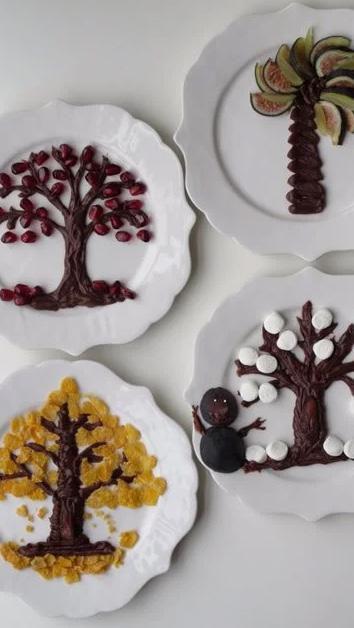
To make the spring tree, add pomegranate seeds to your branches and to the “ground.”
To make the summer tree, slice the figs and grapes into wedges, and layer them decoratively into palm branches.
To make the fall/autumn tree, scatter cornflakes around the branches and on the “ground.” Then add a few more cornflakes to make it look like the leaves are falling.
To make the winter tree, cut minimarshmallows in half and place them on and around the branches, spacing them apart to create a wintry look.
To add some detail to the trunk of the trees, simply slice a date in half and place it carefully on the trunk. This adds a nice touch and dimension.
Wishing everyone a beautiful Tu BiShevat!
Keeping Jewish | February 2023 |
1-A, 2-C, 3-C, 4-B, 5-C, 6-A, 7-B, 8-B, 9-B, 10-A.
15
QUIZ CRAFT
Glenn Fawcett / U.S. Department of Defense

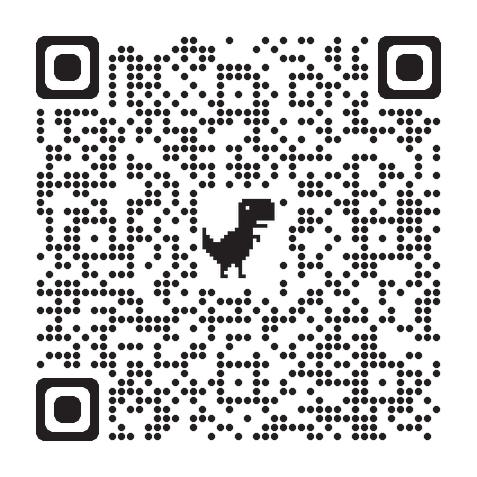
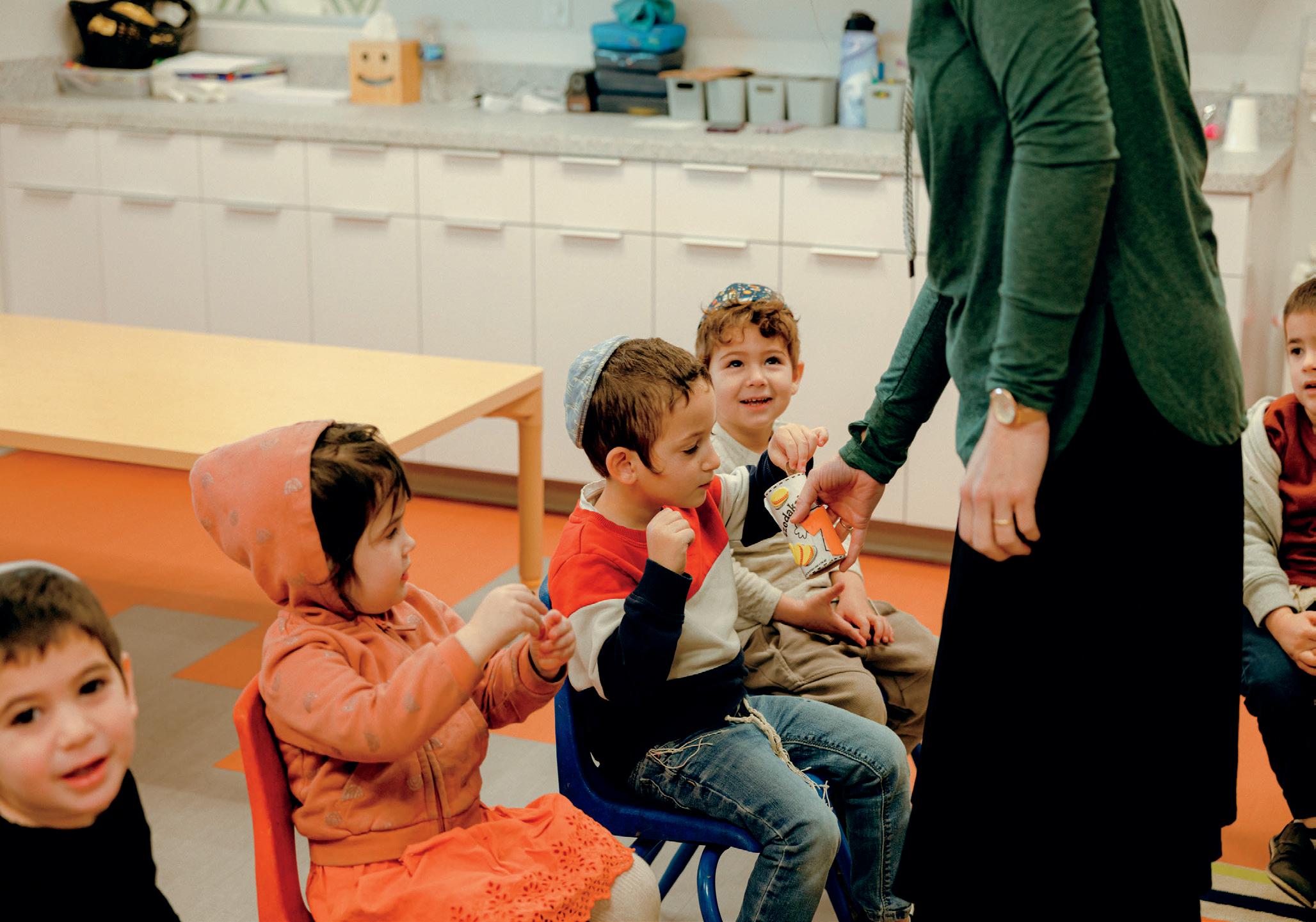
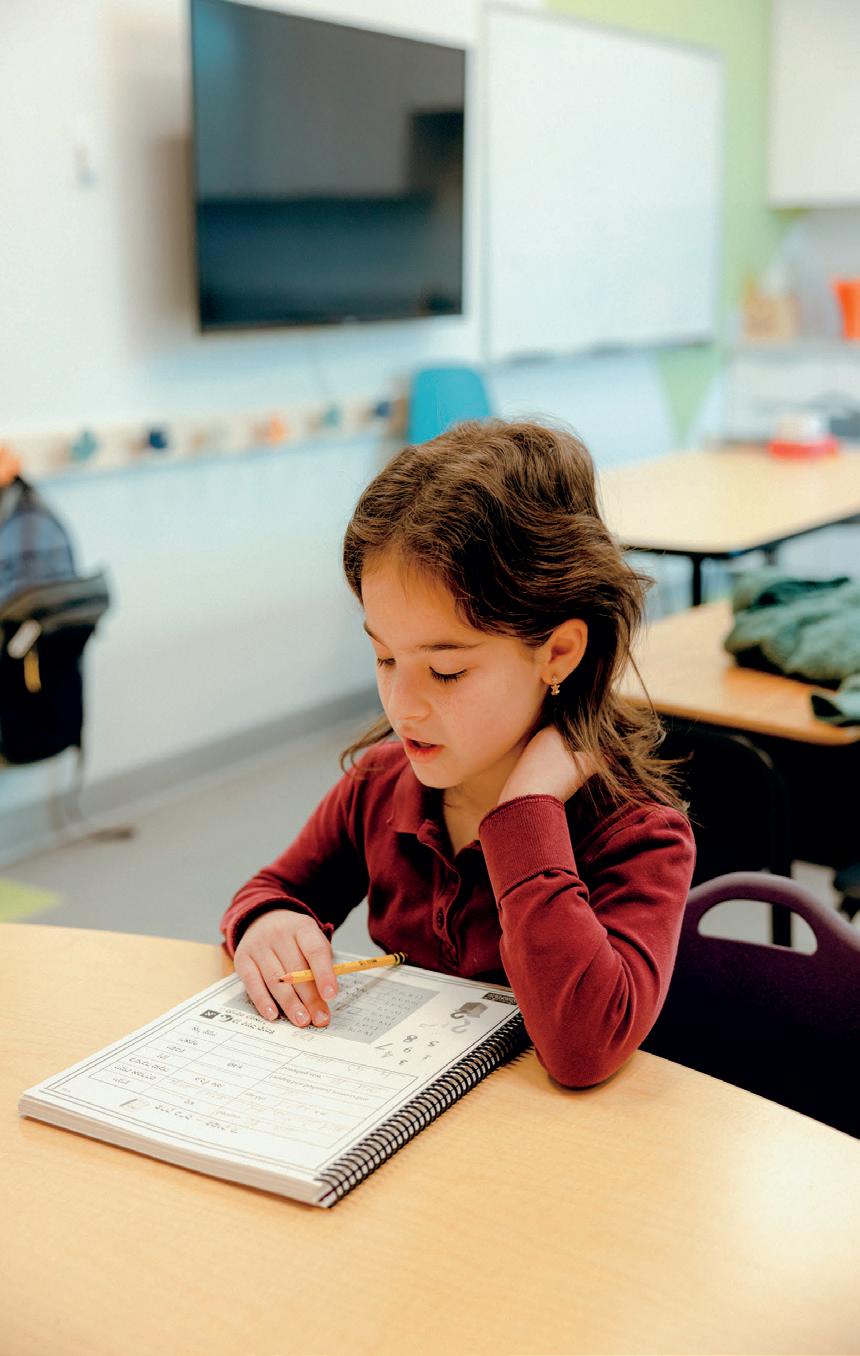

BH Enrollment now open 2023-2024 school year Toddler though 7th grade The Jewish future starts here Lamplighter Chabad Day School & Preschool 3830 E Bellevue St, Tucson, AZ 85719 (520) 881-7956 • Office@LamplighterTucson.com
















 By Benjamin Weiss
By Benjamin Weiss




















